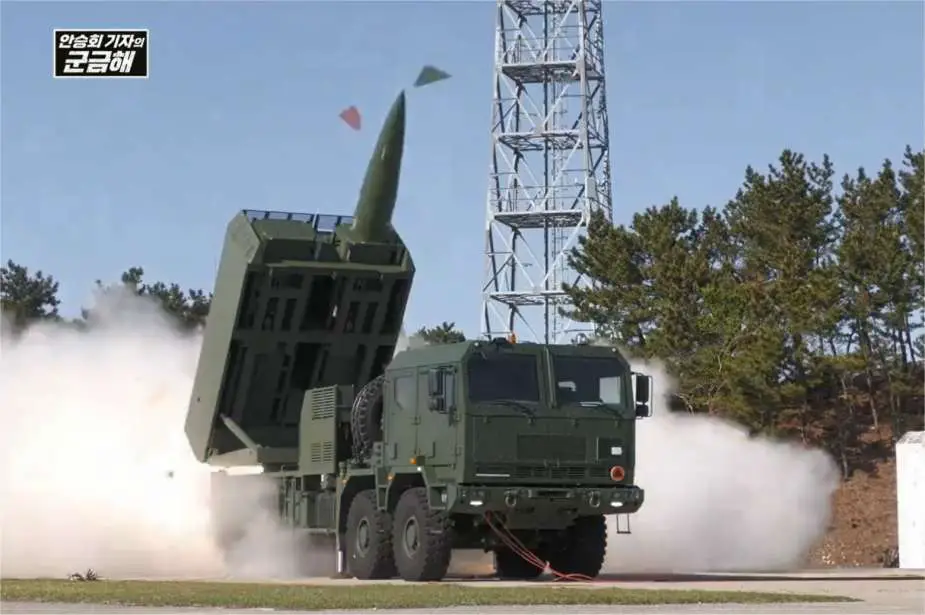South Korea Fires CTM-290 Ballistic Missile Intended for Poland for First Time
On April 24, 2024, South Korea introduced the CTM-290 ballistic missile, designated for Poland. This revelation took place during a launch demonstration using a Homar-K launcher, in the presence of Polish officials. The CTM-290, comparable to the American ATACMS ballistic missile, is designed to enhance the firepower of the Polish military when used in conjunction with other munitions such as the 239 mm rocket.
Follow Army Recognition on Google News at this link

The Homar-K, a custom-designed Polish multiple-launch missile system, incorporates the K239 launcher with a locally produced Jelcz P883.57 8x8 truck chassis. (Picture source: Sout Korean MND)
This event underscores the introduction of advanced Korean-Polish artillery solutions, such as the KRAB 2/3 SPH. Additionally, the South Korean URE missile is recognized for its potential to neutralize North Korean artillery positions. Korea's defense exports have increased by 140%, with Poland playing an important role in this surge.
The Homar-K, a custom-designed Polish multiple-launch missile system, incorporates the K239 launcher with a locally produced Jelcz P883.57 8x8 truck chassis. Equipped with Poland's TOPAZ fire control system, it supports the South Korean 239 mm CGR080 guided missile and the CTM-290 tactical ballistic missile, which has a range of 290 km.
The introduction of the CTM-290 benefits Poland and has sparked interest in Middle Eastern countries such as the United Arab Emirates and Saudi Arabia, which currently deploy the K239 system and are also considering adding the CTM-290 to their arsenal.
The CTM-290 missile is an export variant of the improved Ure-I/KTSSM Block-I missile. It serves as an intermediate solution between the existing Ure-I/KTSSM Block-I missile and the Ure-II/KTSSM Block-II missile, which is currently under development. The CTM-290 shares a similar configuration and shape to the 600 mm Ure-I/KTSSM Block-I but features enhanced performance. It can be launched from a modified Chunmoo launcher, and its range has been extended to about 290-295 km, in line with the provisions of the Missile Technology Control Regime (MTCR).
The missile carries penetrating and thermobaric warheads from the Ure-I/KTSSM Block-I. Unlike the Ure-II/KTSSM Block-II, which is planned to carry a third type of warhead—a high-explosive (HE) warhead. The Ure-I/KTSSM Block-I is a single-stage, 600 mm surface-to-surface tactical ballistic missile with a range of only 180 km, although its warheads were designed to target North Korean bunkers and fortifications.
Furthermore, currently under development, the Ure-II/KTSSM Block-II represents another type of ballistic missile for the Republic of Korea Armed Forces, separate from the export type CTM-290 for the K239L Chunmoo system. Its development was approved by South Korea's Defense Acquisition Program Administration (DAPA) on September 18, 2023. The work is scheduled to continue until December 2027, and the missile will carry an HE warhead over 300 km to directly target enemy sites.
On August 27, 2022, Polish Defense Minister Mariusz Blaszczak announced ongoing negotiations for acquiring the South Korean missile artillery system, which concluded successfully with an agreement on October 13, 2022. The deal included acquiring 288 MLRS Chunmoo systems equipped with Poland's TOPAZ system and 23,000 missiles, with ranges from 80 to 290 kilometers.
This acquisition followed Poland's revised procurement strategy, which initially included 500 M142 HIMARS launchers from the United States but was adjusted due to delays, resulting in a split purchase that included South Korean Chunmoo launchers, with delivery expected in 2023. The first Homar-K unit was officially deployed to the 18th Mechanized Division of the Polish Ground Forces on August 20, 2023, following its final testing in South Korea.
Cooperation on military equipment between south korea and poland continues to expand, and it remains to be seen what other projects the two nations will collaborate on in the future.
Defense News April 2024
- Hits: 3123
















